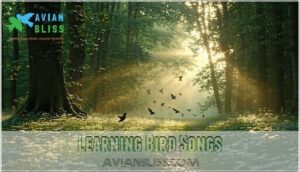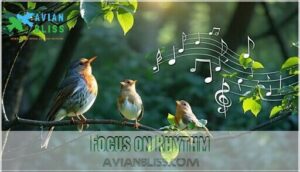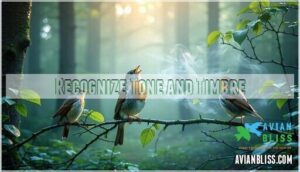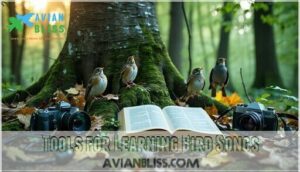This site is supported by our readers. We may earn a commission, at no cost to you, if you purchase through links.

Bird songs and their meanings reveal a complex communication system where each chirp serves a specific purpose.
Males belt out elaborate melodies to claim territory and attract mates, while sharp alarm calls warn of approaching predators.
Contact calls help families stay together during foraging, and begging calls signal hungry chicks, think of it as nature’s social media, where every tweet carries important information about survival, romance, and daily life.
Once you decipher this acoustic code, you’ll discover the secrets behind every morning chorus.
Table Of Contents
- Key Takeaways
- What is Bird Song
- Importance of Bird Song
- Bird Songs and Calls
- Learning Bird Songs
- How to Listen to Bird Songs
- Tools for Learning Bird Songs
- Frequently Asked Questions (FAQs)
- What do different bird songs mean?
- What is the meaning of songs of birds?
- Which bird has the most beautiful song?
- When birds sing, what does it mean?
- What are bird songs meanings?
- Why do birds sing songs?
- Why is bird song important?
- What is the difference between a bird call and a song?
- What is bird song identification?
- How do bird songs help avian communication?
- Conclusion
Key Takeaways
- You’ll discover that bird songs aren’t random noise but sophisticated communication tools where males use complex melodies to defend territory and attract mates, while shorter calls serve immediate needs like warning of danger or maintaining flock contact.
- You can identify bird species more effectively by learning to distinguish between different vocalizations—songs are elaborate performances during breeding season, while calls are brief, functional sounds used year-round for survival communication.
- You’ll master bird song recognition by focusing on four key elements: rhythm patterns, pitch variations, repetition sequences, and tone quality, which serve as each species’ unique acoustic fingerprint in nature’s communication network.
- You can accelerate your learning using digital tools like the Merlin app’s Sound ID feature, audio recording libraries, and mnemonic devices that transform confusing bird chatter into recognizable patterns you’ll confidently identify in the field.
What is Bird Song
You’ve probably heard a robin’s cheerful morning melody or a cardinal’s sharp whistle, but bird songs are actually complex vocalizations produced by specialized vocal organs called the syrinx that serve specific behavioral purposes.
These aren’t random chirps—they’re nature’s sophisticated communication system, each note carrying messages of survival and love.
These aren’t random chirps – they’re sophisticated communication tools that male birds use primarily during breeding season to attract mates and defend their territories from rivals, which is a key aspect of their behavioral purposes.
Purpose of Bird Song
Why do birds fill the dawn with their melodic performances? Bird songs serve as nature’s sophisticated communication system, functioning far beyond simple entertainment.
These vocalizations operate as multi-layered messages that guarantee survival and reproductive success.
Each song carries specific biological purposes:
- Territory Defense – Males establish and maintain their claimed areas
- Mate Attraction – Complex melodies showcase fitness and genetic quality
- Species Identification – Unique vocal signatures prevent cross-species confusion
- Social Bonding – Flock members maintain connections through contact calls
- Bird Communication – Essential information about food sources and threats travels instantly
Understanding these purposes transforms casual listening into meaningful interpretation of avian conversations.
Structure of Bird Song
Think of bird songs as nature’s symphonies built from precise components. Song structure begins with notes forming syllables, which combine into melodic phrases.
The syrinx function enables birds to create complex harmonies simultaneously. Song patterns vary dramatically—some species follow rigid sequences while others improvise freely.
Vocal learning shapes these sonic complexity levels as young birds mimic adults. Spectrogram analysis reveals each species’ unique song visualization, helping decode their intricate communication through detailed bird song sound analysis and bird song rhythm patterns.
Understanding the bird songs guide is essential for identifying various bird species and their unique vocalizations.
Types of Bird Vocalizations
Understanding bird vocalizations opens a window into nature’s sophisticated communication system.
Nature’s symphony reveals a hidden language where every chirp, trill, and call carries meaning worth decoding.
You’ll discover four main categories that birds use to navigate their world:
- Alarm Calls: Sharp, urgent notes warning of predators or threats
- Contact Calls: Soft sounds maintaining flock cohesion during foraging
- Flight Calls: Coordination signals used by migrating species
- Mimicry Sounds: Imitations of other species or environmental noises
Importance of Bird Song
You’ll discover that bird songs serve as nature’s communication network, helping you identify species, understand behaviors, and connect with wildlife in ways you never imagined.
These vocalizations aren’t just pleasant sounds—they’re essential tools for territory defense, mate attraction, and survival that offer valuable insights into ecosystem health and bird population dynamics.
Identifying Birds by Sound
Nature’s symphony offers a powerful key to species identification through distinctive sound patterns.
Each bird’s vocalizations serve as acoustic fingerprints—mockingbirds mimic car alarms while chickadees vary their "dee" calls based on threat levels.
Audio recognition skills reveal hidden wildlife; many species remain invisible without listening.
Through acoustic analysis of pitch, rhythm, and complexity, you’ll master bird sound recognition and discover the secret conversations happening all around you.
Benefits for Birdwatchers and Nature Enthusiasts
Sound identification transforms your birdwatching experience from casual observation to expert-level exploration. When you decode bird language, you’ll discover species hiding in dense foliage and detect rare visitors before other observers notice them.
This auditory skill connects you deeply with wildlife preservation efforts while enhancing your nature connection through eco tourism adventures. Understanding the complex process of bird song production is essential for appreciating the various benefits of sound identification.
- Expanded Species Detection: Identify birds by their calls even when visual confirmation isn’t possible, dramatically increasing your species count
- Enhanced Environmental Awareness: Recognize alarm calls that indicate predator presence or disturbance patterns in local ecosystems
- Improved Bird Conservation Participation: Contribute valuable data to citizen science projects by accurately documenting species through acoustic identification
- Deeper Nature Sounds Appreciation: Understand the complex communication networks that create the natural soundscape around you
- Advanced Birdwatching Skills: Develop expertise in bird communication that separates novice observers from seasoned naturalists
Role in Bird Communication
Beyond identification benefits, bird vocalizations form the backbone of complex avian communication systems.
Each species develops unique communication styles through vocal learning, creating intricate bird language networks.
Males broadcast territorial song structure patterns while females respond with specific call patterns that signal interest or rejection.
Bird signals vary dramatically – ravens produce thirty-three distinct vocalizations, while chickadees adjust their "dee" repetitions to indicate threat severity.
These bird songs and calls coordinate everything from flock movements to predator warnings.
Bird vocalizations reveal social hierarchies, mating readiness, and environmental responses, transforming casual chirping into sophisticated bird communication you can decode with practice.
Bird Songs and Calls
You’ll quickly notice that birds produce two distinct types of vocalizations that serve different purposes in their daily communication.
Songs are complex, melodic sequences males use primarily during breeding season to attract mates and defend territory.
While calls are shorter, simpler sounds both sexes use year-round for immediate needs like warning of danger or maintaining contact with their flock.
Key Differences Between Songs and Calls
While bird songs and calls might sound like nature’s random chatter, they’re actually distinct vocalization types with specific purposes.
Songs are complex, melodic performances lasting several seconds, showcasing intricate patterns for territorial defense and mate attraction. Bird calls are brief, functional sounds—usually one or two notes—designed for immediate communication needs.
Understanding these bird communication differences transforms your listening experience:
- Songs captivate with their elaborate melodies and rhythmic complexity
- Calls command attention through their urgent, direct messaging
- Song complexity reveals a bird’s fitness and breeding readiness
- Call functions guarantee survival through instant alerts and coordination
By mastering bird song recognition, enthusiasts can deepen their connection with nature and improve their identification skills.
Types of Bird Calls
You’ll encounter several distinct types of bird calls during your listening adventures.
Alarm calls sound sharp and urgent when danger lurks nearby. Contact calls are soft, brief sounds that keep flocks connected while foraging.
Flight calls help migrating birds maintain formation mid-air. Begging calls from hungry chicks create persistent, high-pitched pleas for food.
Some species produce mimicry sounds, copying other birds or environmental noises to establish territory and confuse competitors.
Meaning of Bird Vocalizations
Deciphering bird vocalizations reveals nature’s communication network.
Each species uses distinct Bird Language through Song Patterns and Call Functions for Species Identification.
Males sing complex melodies to attract mates and defend territories, while alarm calls warn of predators.
Vocal Learning helps birds develop these skills.
Understanding bird sound meaning reveals whether they’re courting, warning, or maintaining social bonds within their community.
Learning Bird Songs
You’ll master bird song identification through a combination of visual observation, audio practice, and community learning that mirrors how young birds acquire their vocal repertoires.
These proven techniques transform what seems like an overwhelming chorus into recognizable patterns, making each morning walk a chance to decode the acoustic conversations happening around you.
Use Your Eyes to Help Your Ears
Your eyes reveal the secret to bird song identification. Visual Cues paired with Vocal Patterns create powerful memories that stick.
Watch how the bird moves—does it hop, flutter, or perch motionless? Field Observation reveals behavioral clues that enhance species identification.
Key visual elements to observe:
- Head movements and posture during singing
- Wing positioning and tail flicks
- Feeding behavior and flight patterns
- Habitat preferences and perching spots
Visual confirmation transforms confusing sounds into confident bird sound analysis.
Learn From Others
A seasoned birder’s wisdom can reveal bird song learning secrets you’d never discover alone.
Mentor Guidance from experienced enthusiasts accelerates your understanding of complex vocalizations and bird song interpretation techniques.
Community Engagement through local birding groups creates opportunities for Social Learning that books can’t match.
During guided field trips, you’ll witness firsthand how experts analyze bird sound analysis patterns and decode territorial calls versus alarm signals.
Expert Insights shared during group walks reveal subtle differences between species’ songs that your untrained ear might miss.
These mentors teach you to recognize seasonal variations and regional dialects that affect bird song meaning.
Peer Review sessions where fellow birders discuss their observations strengthen your analytical skills.
You’ll learn mnemonic devices, timing patterns, and habitat-specific behaviors that enhance your ability to learn bird songs effectively.
Joining citizen science projects connects you with passionate individuals who share discoveries and celebrate breakthrough moments together, making your journey more rewarding.
Use Sound ID in Your Merlin App
You’ll find the Merlin app’s Sound ID feature transforms bird identification into an adventure.
This powerful tool uses advanced audio analysis to recognize over 1,300 species through sophisticated sound recognition technology. Simply open the app, tap record, and hold your device toward singing birds.
The app’s machine learning algorithms analyze spectrograms in real-time, providing instant species suggestions based on your location. Perfect for digital fieldwork, it works offline and identifies birds even when visual observation isn’t possible.
While challenging with overlapping songs, this sound ID app revolutionizes bird song identification for nature enthusiasts everywhere.
The accuracy of Merlin Sound systems relies on complex algorithms and extensive species databases.
Listen to Recordings
Recording libraries open up a treasure trove of bird sound learning opportunities right from your living room.
You’ll discover how birdsong recordings capture subtle vocal patterns that live encounters might miss. Focus on audio quality when selecting recordings – crisp, clear samples make sound analysis substantially easier.
Professional bird sound recording collections often include multiple examples of each species, helping you recognize individual variations. Pay attention to recording tips from experienced birders who’ve captured these sounds in natural settings.
Compare different recordings of the same species to understand regional dialects and seasonal changes. This methodical approach to bird sound interpretation builds your identification skills systematically, preparing you for real-world encounters where bird identification happens in seconds rather than minutes.
Utilizing high quality birdsong products can greatly enhance your learning experience.
Mnemonics Can Help
Struggling to learn bird songs? Memory aids like bird song mnemonics can make it a breeze! These learning tricks turn vocal cues into catchy phrases, helping you lock in song patterns effortlessly.
- Chickadees: “chicka-dee-dee-dee,” like cheerful gossip.
- Carolina Wren: “tea-kettle, tea-kettle,” a tea lover’s chant.
- Eastern Phoebe: “fee-bee,” its name in two notes.
- White-throated Sparrow: “Oh-sweet-Canada,” a national anthem.
Mind maps or stories tied to these phrases make bird song recognition fun and unforgettable.
How to Listen to Bird Songs
You’ll discover that effective bird song analysis requires focused attention to four key acoustic elements: rhythm, pitch, repetition patterns, and tone.
Training your ear to identify these distinct vocal characteristics transforms confusing background chatter into recognizable species-specific communication patterns.
That reveal territorial boundaries, mating behaviors, and alarm responses.
Focus on Rhythm
Bird songs are a symphony of Melodic Patterns and Rhythmic Cues, each species with a unique beat.
The rhythm—whether steady chirps or intricate trills—serves as nature’s timekeeper. For instance, robins’ even rhythmic song patterns quicken at dawn to establish territory.
Recognizing trill pattern analysis can reveal excitement or alarm, while temporal variations in repetitive songs hint at behavior changes.
By tuning into the beat analysis of bird songs, you’ll uncover their sonic texture and purpose, like group coordination or mate attraction. Next time you listen, think of rhythms as codes revealing fascinating worlds of avian communication.
Pay Attention to Pitch
When tuning into bird songs and calls, noticing pitch variations can be revealing.
Smaller birds, like warblers, emit high-pitched sound waves, while larger species, like owls, stick with low frequencies.
- High vs. Low: A robin’s chirps contrast a dove’s soft coos.
- Unique Frequencies: Birds have specific vocal acoustics.
- Noise Impact: Urban life pushes song pitch higher.
- Skill Showcase: Complex frequency analysis reflects adaptability.
Use auditory perception tools like apps to explore!
Identify Repetition Patterns
Nature’s musical library holds countless Song Patterns that serve as each species’ unique signature.
When you tune into repetition patterns, you’re basically learning bird languages through their Melodic Structures.
Listen for Vocal Cues that repeat consistently—some birds deliver the same phrase three times, while others cycle through complex sequences.
Repetition Analysis reveals fascinating insights: robins typically repeat phrases four to six times, while cardinals often belt out their "birdy-birdy-birdy" motif repetition endlessly.
Here’s your field guide breakdown:
Trill pattern analysis
Motif repetition
Syllable repetition
Rhythmic Variations
Mastering bird song repetition patterns transforms confusing chatter into meaningful conversations—you’ll decode nature’s secret messages effortlessly.
Recognize Tone and Timbre
When listening to bird songs, focus on vocal timbre—the unique acoustic qualities that distinguish each species.
These vocal fingerprints emerge through frequency analysis and auditory perception. A robin’s flute-like clarity differs from a crow’s harsh rasp.
Pay attention to sound waves and sonic patterns to recognize timbral nuances. This bird song tone recognition transforms confusing chatter into clear species identification.
Understanding bird song patterns is essential for accurate species identification.
Tools for Learning Bird Songs
Now that you’ve trained your ears to recognize rhythm and pitch patterns, let’s explore the digital toolkit that’ll accelerate your bird song learning journey.
Bird Apps like Merlin’s Sound ID feature provide instant bird song identification through real-time analysis. The Larkwire app offers structured lessons with three difficulty levels, while Chirp! combines photos with audio quizzes.
Audio Recordings from Peterson’s Birding by Ear CDs organize songs by type, making pattern recognition easier. For serious bird sound analysis, try spectrogram software that converts melodies into visual representations—it’s like seeing sound waves dance.
Learning Strategies include mnemonic devices ("Quick, three beers!" for Olive-sided Flycatcher) and field guides with sonograms. Online resources like Xeno-canto.org offer extensive Vocal Patterns libraries.
These tools transform bird song recognition from guesswork into systematic Sound Analysis, making you fluent in nature’s acoustic language. Utilizing bird app resources can further enhance your understanding of bird songs and their meanings.
Frequently Asked Questions (FAQs)
What do different bird songs mean?
Ever wonder what birds are actually saying?
You’re hearing territorial claims, mate attraction calls, and danger warnings.
Each species uses unique vocalizations—songs defend territories while shorter calls communicate immediate needs like food or threats.
What is the meaning of songs of birds?
Birds use songs to attract mates, defend territory, and communicate danger.
You’ll hear complex melodies during breeding season for courtship, while shorter calls warn of predators or maintain flock contact throughout the year.
Which bird has the most beautiful song?
What makes one melody more enchanting than another?
You’ll find the Nightingale’s complex, flute-like phrases most enchanting, though Wood Thrushes and Hermit Thrushes deliver equally stunning performances with their ethereal, bell-like tones.
When birds sing, what does it mean?
When you hear birds singing, they’re communicating specific messages: males defend territory and attract mates, while calls coordinate flock activities, warn of predators, or maintain contact during foraging and migration.
What are bird songs meanings?
Like nature’s telegraph system, you’re hearing birds communicate essential messages through their songs.
They’re claiming territory, attracting mates, warning of danger, and maintaining social bonds with their flock members throughout the day, which can be seen as essential messages and a way of claiming territory.
Why do birds sing songs?
Male songsters belt out melodies to claim territory and attract mates during breeding season.
You’ll hear them defending prime real estate while showcasing their fitness—it’s nature’s way of advertising "I’m available and worth it!
Why is bird song important?
Bird song serves as nature’s communication network, helping you identify species, understand territorial behavior, and monitor ecosystem health.
It’s essential for mate attraction, predator warnings, and maintaining social bonds within avian communities, which can be considered a key aspect of ecosystem health.
What is the difference between a bird call and a song?
Songs flow like elaborate symphonies while calls snap like urgent telegrams.
You’ll notice songs are complex melodies males use for territory and mates, whereas calls are shorter, simpler sounds both sexes use year-round for immediate communication needs.
What is bird song identification?
You’re learning to recognize and distinguish different species based on their unique vocalizations.
It involves analyzing pitch, rhythm, and patterns in songs and calls to accurately identify which bird you’re hearing in the field, using techniques that help in distinguishing different species.
How do bird songs help avian communication?
You’d think feathered creatures would just tweet randomly, but they’re actually running sophisticated communication networks.
Through territorial defense, mate attraction, alarm systems, and flock coordination, avian vocalizations create complex social structures that maintain species survival and reproductive success.
Conclusion
Next time you hear a robin’s cheerful melody at dawn, you’ll know it’s claiming territory and seeking a mate.
Understanding bird songs and their meanings transforms every outdoor experience into a fascinating glimpse into avian behavior.
You’ve learned to distinguish territorial songs from alarm calls, contact notes from begging sounds.
With practice using field guides, apps, and careful listening techniques, you’ll decode the complex acoustic conversations happening all around you, and discover Nature’s secret language awaits your discovery, which is a fascinating glimpse into avian behavior.













